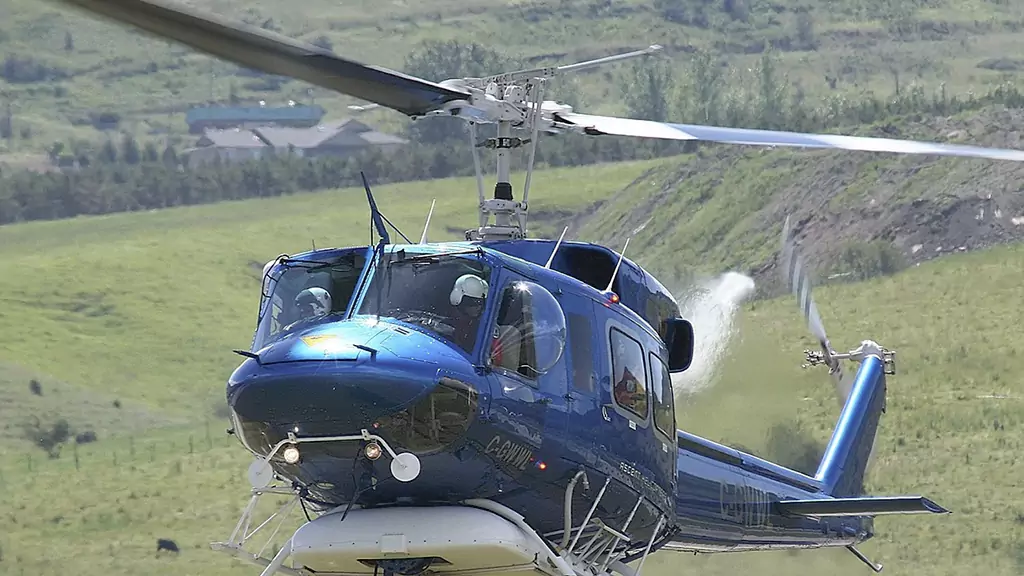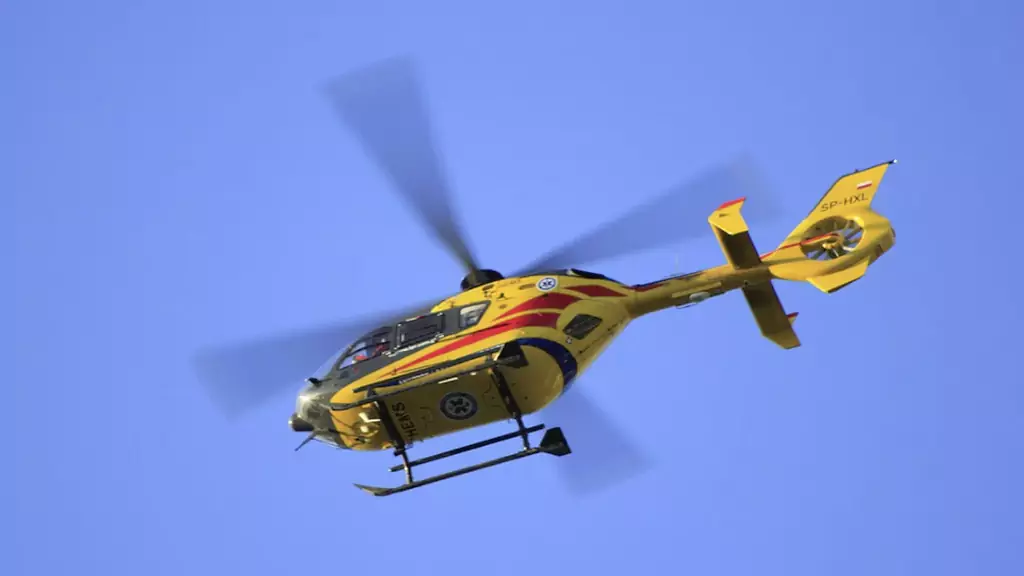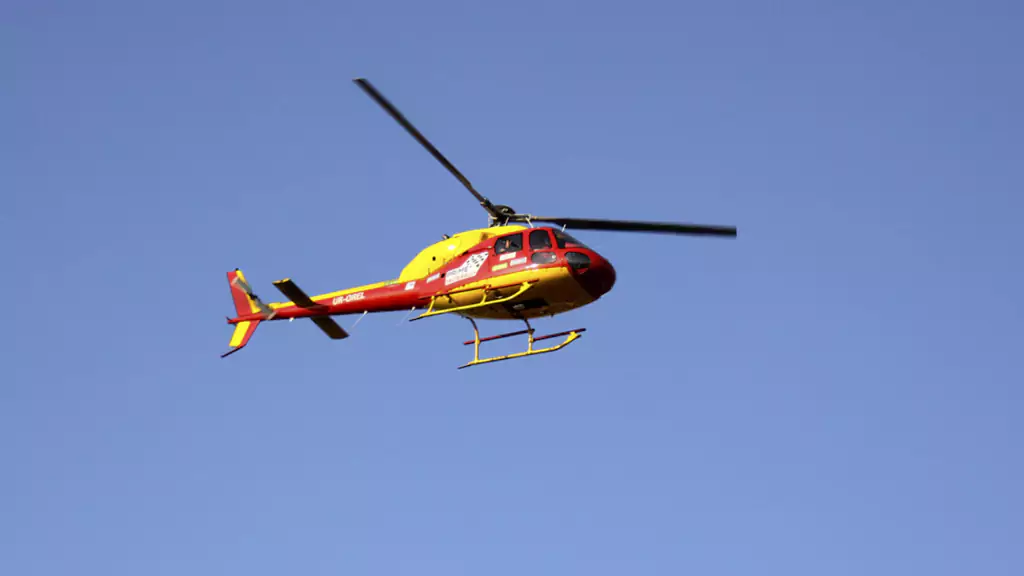How far can a helicopter fly? – You might be wondering how thrilling it would be to take a helicopter trip and take in the scenery from above.
But before you book your trip, it’s important to understand some of the basics of helicopters. To begin with, helicopters are one of the most economical types of aircraft to fly.
The reason is that helicopters can hover in the air and not have to use nearly as much fuel as they would if they were moving forward, like airplanes do.
The size of a helicopter also allows it to land in places that other aircraft might not be able to reach. When you visit Las Vegas, you’ll see more than your fair share of helicopters.
How Far Can a Helicopter Fly?
One basic question is how far a helicopter can fly. The answer is that it depends on the weight of the helicopter and the amount of fuel it has on board.
Generally, a helicopter can fly for around three hours without refueling. Of course, the aircraft’s range will vary depending on the aircraft type, weather conditions, and what kind of maneuvers it is required to perform.
Here’s an example: A helicopter has 1,500 pounds of fuel on board and weighs 10 tons. It can fly about 300 miles before refueling.
That distance could be lengthened if the pilot took on more fuel before starting the trip. But it could be shortened if the helicopter was required to fly in hotter weather, which would require more power and thus burn more fuel.
Operating at higher altitudes will also reduce range because there is less air to push against. So, if you are looking for a longer helicopter sightseeing trip, look for one that will fly lower to the ground.
So, how far can a helicopter fly? It depends on the weight and fuel capacity of the aircraft, as well as environmental factors.
But in general, you can expect a helicopter to be able to travel for around three hours without refueling. So get your planning done and start packing your bags.
Average Speed of a Helicopter
The average speed of a helicopter in forward flight is 100 knots (115mph, 185 kph). This speed can be increased to 160 knots (180 mph or 290 kph) if the engine power is doubled.
The helicopters that are considered to have high speed are those with an airspeed of over 300 knots (350 mph, or 560 kph).
Some fast helicopters are the Eurocopter EC-665 Tiger, Boeing AH-64 Apache attack helicopter, Mil Mi-28N Havoc and Kamov Ka-52 “Alligator”.
The Type Of Helicopter Determines How Far and High It Can Fly
Identifying the types of helicopters will be able to tell you how far they can go, how much weight they can carry, and how high they can go.
Sail
can travel a distance of over 100 miles. They are generally old, used as training helicopters or for small oil rigs.
Commercial
This type of helicopter is the most common and also the least expensive. They have a cargo space of about 2-3 tons, a range of about 200 miles, and can fly up to 10,000 feet. This is also the most popular among civilians and companies.
Military
The maximum weight is about 24 tons, and the maximum altitude is 45,000 feet. Used frequently in combat or for medical evacuations,
Transport
maximum range of over 400 miles with a carrying capacity of 20–25 tons. It can reach altitudes of over 20,000 feet. It is primarily used for moving troops, equipment, and supplies in a short amount of time.
There are many different types of helicopters, each with their own benefits and limitations. Knowing the type of helicopter you are flying will give you a good idea of how far it can go and how high it can fly.
So the next time you are in a helicopter, be sure to ask your pilot what type it is!
How High Can A Helicopter Fly?
In general, a range of 500 feet is considered the conventional height at which helicopters may fly with freedom, taking safety into account.
A helicopter’s main limitation is the downwash created by its main rotor, as it can only produce a limited amount of lift.
The maximum altitude for a standard helicopter is 10,000 feet. So-called “high performance” helicopters have been developed with higher service ceilings, and some advanced models may allow flight at altitudes of up to 12,500 feet.
Aircraft such as the Blackhawk and Apache are designed for military purposes and can fly up to 20,000 feet.
However, due to the conditions at high altitudes, thin air, extreme cold and less oxygen, pilots must take care to avoid hypoxia, or a lack of oxygen in the blood that can lead to disorientation, loss of consciousness and even death.
At very high altitudes, a helicopter pilot faces other challenges as well. Helicopters are more susceptible to wind shear and turbulence, so flying in these conditions can be extremely dangerous.
In the event of an emergency landing, there may not be enough space to set the aircraft down, and it can be difficult to see obstacles or avoid them.
While helicopters cannot operate at high altitudes without special modifications, such as pressurized cockpits and environmental controls, planes often fly much higher than helicopters due to the nature of their designs.
Many different types of aircraft can fly well above 10,000 feet. For military purposes, aircraft can fly as high as 30,000 feet or more. Commercial airliners typically cruise at an altitude of 36,000 feet or more.
So the answer to the question “How high can a helicopter fly?” is that it depends on the type of helicopter and its purpose. Generally, though, 500 feet is considered the ideal height.
At high altitudes, a helicopter pilot must take into account the lack of oxygen, wind shear, and turbulence. Nevertheless, some helicopters are capable of flying much higher with special modifications.
Legal Requirements For Helicopters’ Flight Range
Helicopters, like aircraft, are obliged to obey strict government laws and regulations when flying.
One of the most important of these is to ensure that the helicopter’s flight range does not exceed the distance it is legally allowed to fly.
For helicopters, this distance is typically measured in terms of “nautical miles”. This is a unit of measurement that takes into account both the helicopter’s height and speed.
It is important to ensure that your helicopter’s maximum range does not exceed this limit, as doing so could put you in violation of government regulations.
In order to stay within the bounds of the law, it is important to know your helicopter’s specific flight range.
You can find this information in your aircraft’s flight manual. Be sure to consult this document before every flight in order to ensure that you are flying within the bounds of the law.
If you are ever unsure about whether or not you are allowed to fly in a particular area, it is always best to contact the local authorities and ask for their advice.
Ignorance of the law is never an excuse, and violating government regulations can result in hefty fines or even imprisonment.
So be sure to familiarize yourself with the legal flight range for your helicopter, and always fly within those bounds. By doing so, you can help ensure that you stay safe and avoid any potential legal trouble.
Factors Affecting the Helicopter Range
As already mentioned, the helicopter is a more complex machine than the plane, and, of course, it has some extra limitations that are not present on the plane.
Some of these limitations are related to aerodynamics how the helicopter behaves in the presence of air currents around it, and some are related to the mechanical properties of the helicopter itself.
Both aerodynamic factors and mechanical factors affect the helicopter range.
Aerodynamic Factors
The main aerodynamic factor that affects the helicopter’s range is the amount of lift that the helicopter can generate.
The more lift the helicopter can generate, the higher it can fly and the further it can travel. Different factors affect the amount of lift that a helicopter can generate, including the speed of the helicopter, the shape of the rotor blades, and the angle of attack.
The speed of the helicopter is important because it determines how much air the propellers can move per second. The more air that is moved per second, the more lift is generated.
However, as the speed of the helicopter increases, so does the amount of drag that is created. Drag is the resistance to movement that is created by the air particles flowing around the helicopter.
So, there is a trade-off between speed and range; the faster the helicopter goes, the shorter its range will be.
The shape of the rotor blades also affects how much lift is generated. The more curved the blades are, the more lift they generate.
However, as the blades become more curved, they also create more drag. So, there is again a trade-off between lift and drag.
The angle of attack is the angle at which the rotor blades are tilted relative to the airflow. When the angle of attack is increased, the lift also increases.
However, at a certain point, increasing the angle of attack will start to decrease the lift. This is because at high angles of attack, the airflow starts to separate from the blade surface, which reduces the amount of lift that is generated.
Mechanical Factors
The main mechanical factor that affects the helicopter’s range is the amount of power that the engine can produce. The more power that is available for use, the faster and higher the helicopter can fly.
There are also some secondary mechanical factors that affect the range. One such factor is the weight of the helicopter. As we know, heavier helicopters will need more power to be able to fly and will therefore have a shorter range.
Another factor that affects the helicopter range is the fuel efficiency of the engine. The more efficient the engine is, the further the helicopter can travel on a given amount of fuel.
And finally, the size and shape of the helicopter also affect range; larger helicopters have more surface area relative to their weight, which means they experience more drag than smaller helicopters.
This increases the amount of power that is needed to keep them in the air, which reduces their range.
So, as you can see, there are a number of factors that affect the helicopter’s range. The main ones are the aerodynamic factors (the speed, shape, and angle of attack of the rotor blades) and the mechanical factors (the power and fuel efficiency of the engine).
How important each of these factors is depends on the specific helicopter and the mission that it is being flown on. For example, if a helicopter needs to fly quickly to a destination, speed will be more important than fuel efficiency.
But if it needs to fly for a long distance, then fuel efficiency will be more important.


